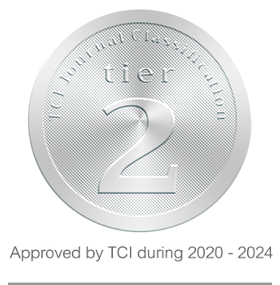Botanical Characteristics for Traditional Robusta Coffee in Lower Southern Region, Thailand
Keywords:
Surveying, Plant genetic, DiversityAbstract
Study of traditional Robusta coffee in lower southern region was done for good variety selection and genetic relationship analysis. This experiment was carried out at Trang Horticultural Research Centre during October 2020 – September 2021. Traditional Robusta Coffee were surveyed and collected in Krabi, Songkhla, Satun, Trang and Yala Province for data collection of botanical characteristics, good variety and genetic relationship analysis. According to the survey from 2 zone in the Eastern and Western coast with the total of 20 sites, the Robusta coffee trees are 49-102 years old in range. To select coffee with good characteristics, high number of node frequencies, the length of node is not more than 8 cm, high number of fruit per nod and large fruit size are concerned. In this study, traditional Robusta coffee from two sites were selected. The first was NSK3 in the area of Na-Thawi District, Songkhla Province, the tree is 102 years old, number of node frequencies was 11.3 nodes/branch, short nod length was 5.4 cm. The numbers of fruit per nod was 16.9 fruits/nod and large fruit size of 2.3 cm. The second was ST3 in the area of Khuan-Kalong District, Satun Province, the tree is 95 years old, number of node frequencies was 11.3 nodes/branch, the nod length was 6.8 cm. and number of fruit per nod was 29.0 fruits/nod. The cleft grafting of Robusta coffee, it was found that TR1 has the highest percentage of survival. Genetic relationship study showed that Traditional Robusta coffee can be divided into 3 groups. Group 2 which includes SSK1, SSK2, SSK3, SSK4, ST1, ST2, ST3, TR1 and YL1, exhibit genetic similarity to Chumphon 2. This group is assumed to be the first group planted in Sa-ba-Yoi District, Songkhla Province. Deviated genetic could be resulted from seed propagation.
References
Aiumsumang, S. and Phimphan, S. 2020. Genetic diversity in coffee (Coffea arabica) from Khao Kho District Phetchabun Province by SSR marker technique. Khon Kaen Agriculture Journal 48 (SUPPL1): 515-524.
Chiarawipa, R. and Sirikantayakul, C. 2015. Traditional Robusta Coffee in Satun Province: The values in a community-based conservation. In Long Lae (Collected Article in PSU). No.7, pp. 82-85. Songkhla: Research and Development Office, Prince of Songkla University.
Department of Agricultural Extension. 2014. Thai coffee history. In Optimizing Coffee Production. pp. 9-10. Bangkok: Agricultural cooperative printing demonstrations of Thai co., Ltd.
Department of Agriculture. 2019. Coffee Strategy 2017–2021. Available from: https://www.doa.go.th. (accessed on 11 January 2020).
Healey, A., Furtado, A., Cooper, T. and Henry, RJ. 2014. Protocol: a simple method for extracting next-generation sequencing quality genomic DNA from recalcitrant plant species. Plant Methods 10: 21. DOI :10.1186/1746-4811-10-21.
Horticultural Research Institute. 2019. Robusta coffee varieties. In Robusta Coffee Production. pp. 2. Bangkok: guarantee.
Office of Agricultural Economics. 2013. Coffee. Available from: https://mis-app.oae.go.th/product/%e0%b8%81%e0%b8%b2%e0%b9%81%e0%b8%9f. (accessed on 11 January 2020).
Prasad, H. and Ramesh, K.A. 2014. Development of genic and genomic SSR markers of Robusta coffee (Coffea canephora Pierre Ex A. Froehner). PLoS ONE 2: DOI:10.1371/journal.pone.0113661.
Sriwat, W. 2016. Saba Yoi Coffee, Songkhla Province: Thailand's first Robusta origin. News Southern. Available from: https://www.paaktai.com/news_economy/detail/1674/data.html (accessed on 11 January 2020).
Thavornrat, T. 2005. Coffee Development in Thailand. Available from: http://lib.doa.go.th/multim/e-book/EB00175.pdf. (accessed on 11 January 2020).
Tummakat, A. and Thanomthin, V. 1986. Robusta coffee history. THAI Agricultural Research Journal 4: 174-177.
Downloads
Published
How to Cite
Issue
Section
License

This work is licensed under a Creative Commons Attribution-NonCommercial-NoDerivatives 4.0 International License.



